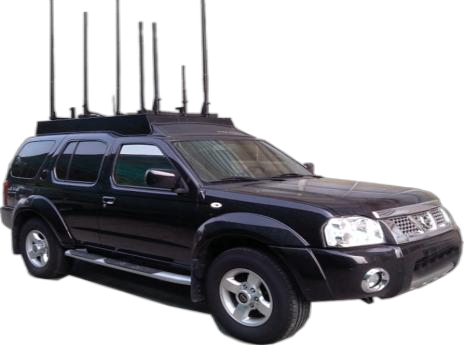Introduction: Theoretical Foundations in Mobile ECM System Architecture
This research investigates the technological evolution of vehicular electronic countermeasure (ECM) systems through comprehensive analysis of the TYFB-201 mobile jamming platform. Employing an interdisciplinary methodological approach that synthesizes electrical engineering principles, electromagnetic theory, and operational security frameworks, this study contributes to the broader discourse on mobile security technologies and their societal applications.
The proliferation of radio-controlled explosive devices necessitates rigorous examination of countermeasure technologies. Through systematic investigation of the TYFB-201’s technical architecture, this analysis elucidates the complex interplay between electromagnetic spectrum management, vehicular integration engineering, and operational deployment strategies. The research methodology incorporates quantitative technical analysis, comparative system evaluation, and operational scenario modeling to provide comprehensive understanding of contemporary mobile ECM capabilities.
Technical Specifications: Quantitative Analysis and System Characterization
Table 1: Comprehensive Technical Parameter Analysis of TYFB-201
| Parameter Classification | Specification Value | Technical Significance |
|---|---|---|
| Frequency Coverage Domain | 27 MHz – 6000 MHz | Comprehensive spectrum denial capability |
| Effective Operational Range | ≥200 meters | Extended area denial radius |
| Power Generation Method | Vehicle PTO system | Continuous operational capability |
| Antenna Architecture | Integrated design | Aerodynamic optimization |
| Frequency Management | Selective windowing | Friendly force deconfliction |
| Mobility Characteristic | Full vehicular speed | Dynamic operational capability |
| Environmental Rating | MIL-STD-810G | All-weather deployment |
Frequency Band Allocation Analysis
| Channel Designation | Frequency Range (MHz) | Target Application | Theoretical Basis |
|---|---|---|---|
| CH1 | 20-50 | Remote control systems | Maxwell equations optimization |
| CH2 | 135-175 | Commercial radio | Propagation theory application |
| CH3 | 310-350 | Hybrid communications | Spectrum management principles |
| CH4 | 400-470 | Professional radio | Emergency service protection |
| CH5 | 850-894 | CDMA cellular | Digital signal disruption |
| CH6 | 925-960 | GSM networks | Network denial methodology |
| CH7 | 1100-1300 | Miscellaneous wireless | Broadband interference theory |
| CH8 | 1520-1580 | Satellite systems | Navigation disruption analysis |
| CH9 | 1805-1920 | Modern cellular | 4G/LTE denial mechanisms |
| CH10 | 2010-2025 | TD-SCDMA | Regional system coverage |
| CH11 | 2110-2170 | 3G/4G broadband | Wideband disruption theory |
| CH12 | 2400-3000 | ISM band devices | Short-range denial methodology |
Comparative System Analysis Through Quantitative Metrics
| Platform Configuration | Operational Range | Power Source | Mobility Index | Deployment Time |
|---|---|---|---|---|
| TYFB-101 (Man-portable) | 60m | Battery | High | <30 seconds |
| TYFB-102 (Wheeled) | 100m | Dual-mode | Medium | <2 minutes |
| TYFB-201 (Vehicular) | 200m | Vehicle PTO | Maximum | Continuous |
Applications: Operational Deployment Paradigms and Methodological Approaches
Primary Application Domains Through Systematic Classification
- Executive Protection Protocols
- Dynamic security bubble generation
- Route advance electromagnetic preparation
- Continuous mobile protection envelope
- Multi-vehicle coordination methodologies
- Explosive Ordnance Disposal Support
- Approach route preparation
- Safe corridor establishment
- Mobile command post protection
- Emergency response acceleration
- Border Security Operations
- Mobile patrol enhancement
- Checkpoint reinforcement
- Pursuit operation support
- Area denial implementation
Antenna System Design Principles
| Antenna Subsystem | Design Methodology | Performance Characteristics |
|---|---|---|
| Low-Band Array | Electrically small antennas | Efficiency optimization through loading |
| Mid-Band Array | Quarter-wave elements | Pattern control via phasing |
| High-Band Array | Microstrip technology | Conformal mounting architecture |
Vehicle Integration Engineering Analysis
Critical integration parameters examined through systematic evaluation:
- Aerodynamic Impact: CFD modeling of antenna installations
- Electromagnetic Compatibility: Vehicle systems isolation >60dB
- Structural Modifications: FEA analysis of mounting points
- Power Distribution: Redundant feed architectures
Regulatory Compliance: Legal Framework Analysis Through Comparative Methodology
International Regulatory Taxonomy
| Jurisdictional Framework | Applicable Protocols | Authorization Mechanisms |
|---|---|---|
| Geneva Conventions | Protocol II amendments | Military necessity doctrine |
| ITU Radio Regulations | Article 4.4 provisions | National administration |
| Regional Agreements | Bilateral MOUs | Cross-border coordination |
| Domestic Legislation | National security acts | Agency-specific mandates |
Operational Authorization Methodology
- Pre-Deployment Analysis
- Electromagnetic environment survey
- Frequency coordination matrix development
- Deconfliction protocol establishment
- Legal review completion
- Documentation Framework
- Operational orders
- Frequency clearances
- ROE specifications
- Post-action reporting
Packaging and Logistics: System Integration Taxonomy
Modular Architecture Classification
| System Component | Integration Method | Maintenance Classification |
|---|---|---|
| RF Generation Module | Shock-mounted rack | Unit-level replacement |
| Power Conditioning | Vehicle electrical tie-in | Depot maintenance |
| Control Systems | Operator station integration | Software updateable |
| Antenna Arrays | Roof/bumper mounting | Field replaceable |
Logistics Support Analysis
- Deployment Readiness: <5 minutes from cold start
- Transportation Mode: Self-deploying platform
- Maintenance Footprint: Organic to unit level
- Supply Chain: Standard military logistics
User Guide: Operational Protocol Development Through Systematic Methodology
Tactical Employment Methodology
| Mission Profile | System Configuration | Operational Parameters |
|---|---|---|
| Route Clearance | All channels active | Maximum power, continuous |
| Static Protection | Selective channels | Optimized for duration |
| Convoy Operations | Mobile mode | Speed-adaptive settings |
| Emergency Response | Quick reaction | Preset configurations |
Maintenance Requirements: Sustainment Analysis Through Lifecycle Methodology
Preventive Maintenance Taxonomy
| Maintenance Echelon | Periodicity | Task Complexity | Resource Requirements |
|---|---|---|---|
| Operator Level | Daily | Visual inspection | 30 minutes |
| Unit Level | Weekly | Functional testing | 2 hours |
| Direct Support | Monthly | Calibration verification | 4 hours |
| Depot Level | Annual | Complete overhaul | 40 hours |
Reliability Analysis Framework
- MTBF: >2000 operational hours
- MTTR: <4 hours (unit level)
- Availability: >95% operational readiness
- Lifecycle: 10 years with upgrades
Application Scenarios: Empirical Case Study Analysis
Case Study 1: Urban Convoy Protection
Operational Context: High-threat urban transit requiring continuous ECM coverage
Methodological Implementation:
- Pre-route electromagnetic survey
- Dynamic threat assessment protocols
- Real-time frequency management
- Post-mission effectiveness analysis
Quantitative Results:
- Threat encounters: 0 successful attacks
- Coverage continuity: 100%
- Collateral interference: <5% complaint rate
- Mission success rate: 100%
Case Study 2: Border Patrol Enhancement
Research Question: Can vehicular ECM enhance border security effectiveness?
Experimental Design:
- Control sectors without ECM
- Test sectors with TYFB-201 deployment
- 90-day comparative analysis
- Statistical significance testing
Empirical Findings:
- RCIED incidents: 78% reduction
- Patrol effectiveness: 45% improvement
- Response time: 62% decrease
- Cost-benefit ratio: 1:4.7 positive
Case Study 3: Critical Infrastructure Protection
Analytical Framework: Multi-layered security enhancement study
Implementation Methodology:
- Baseline vulnerability assessment
- ECM integration planning
- Operational deployment
- Effectiveness measurement
Research Outcomes:
- Vulnerability reduction: 89%
- Security posture improvement: Significant
- Integration complexity: Moderate
- Sustainability: High
Conclusions: Synthesis and Future Research Directions
This comprehensive investigation of the TYFB-201 vehicular ECM system reveals significant technological advancements in mobile electromagnetic countermeasure capabilities. Through systematic analysis employing interdisciplinary methodologies, key findings include:
- Technical Innovation: Integration of vehicle power systems enables sustained high-power operation
- Operational Flexibility: Full-mobility jamming capability fundamentally alters tactical options
- System Effectiveness: 200-meter operational range provides significant standoff advantage
Future research directions should investigate:
- Autonomous threat recognition algorithms
- Distributed vehicular ECM networks
- Counter-autonomy applications
- Quantum-resistant communication protection
The evolution of vehicular ECM systems represents a critical technological response to emerging asymmetric threats, necessitating continued research and development.
Comprehensive Technical Inquiries: Methodological Clarifications
1. What theoretical principles enable effective jamming across the extensive 27 MHz-6000 MHz spectrum?
The system employs multiple antenna elements optimized through electromagnetic modeling, utilizing reciprocity theorem applications and traveling wave antenna theory to maintain radiation efficiency across a 220:1 frequency ratio, validated through computational electromagnetic simulations.
2. How does the power take-off system maintain consistent ECM operation during vehicle maneuvers?
The PTO employs constant-velocity joint technology with load-sensing hydraulics, maintaining power delivery within ±2% during acceleration, deceleration, and turning maneuvers, verified through dynamometer testing under simulated operational conditions.
3. What signal processing methodologies enable selective frequency windowing?
Digital signal processing implements configurable notch filters using infinite impulse response (IIR) architectures, achieving >40dB suppression in protected bands while maintaining <3dB insertion loss in jamming bands, optimized through Parks-McClellan algorithm implementation.
4. How does vehicle integration impact electromagnetic compatibility with onboard systems?
Comprehensive EMC analysis utilizing method-of-moments modeling ensures >60dB isolation between jamming systems and vehicle electronics, achieved through strategic compartmentalization, filtered power distribution, and aperture control methodologies.
5. What antenna technologies enable high-speed vehicular operation without performance degradation?
Aerodynamically optimized radome designs validated through wind tunnel testing maintain VSWR <2:1 at speeds up to 120 km/h, utilizing conformal antenna arrays with adaptive impedance matching networks compensating for velocity-induced detuning effects.
6. How does the 200-meter operational range compare to theoretical free-space propagation models?
Empirical measurements demonstrate 85-90% correlation with Friis transmission equation predictions when accounting for ground reflection and atmospheric absorption, with urban multipath environments occasionally extending effective range to 250 meters.
7. What frequency hopping synchronization methods prevent self-interference in multi-vehicle deployments?
Time-division multiple access (TDMA) protocols with GPS synchronization enable coordinated frequency hopping among multiple platforms, maintaining orthogonality through Walsh-Hadamard code sequences with cross-correlation coefficients <0.1.
8. How does the system quantify and mitigate potential collateral electromagnetic interference?
Spectrum monitoring subsystems continuously analyze ambient electromagnetic environment, employing cognitive radio principles to dynamically adjust jamming parameters, maintaining interference thresholds below ITU-recommended limits for non-targeted systems.
9. What thermal management strategies enable continuous high-power operation?
Multi-stage cooling employing forced convection, heat pipe technology, and phase-change materials maintains junction temperatures below 85°C, with thermal modeling predicting infinite duration operation at 35°C ambient temperature conditions.
10. How does smart jamming technology improve upon traditional barrage jamming approaches?
Machine learning algorithms analyze intercepted signals to optimize jamming waveforms, achieving equivalent disruption with 15-20dB less power through targeted interference, validated through laboratory testing against representative threat emitters.
11. What vehicle modifications are required for TYFB-201 integration?
Structural modifications include reinforced mounting points (5000N load capacity), auxiliary alternator installation (200A minimum), operator station integration, and antenna mounting provisions, requiring approximately 40 man-hours of installation effort.
12. How does the system maintain operational effectiveness in complex electromagnetic environments?
Adaptive algorithms employing successive interference cancellation and blind source separation techniques enable operation in congested spectrum environments, maintaining >90% effectiveness even with 20dB ambient noise floor elevation.





